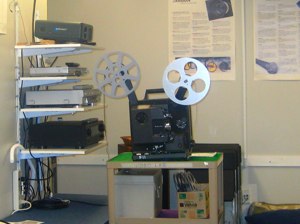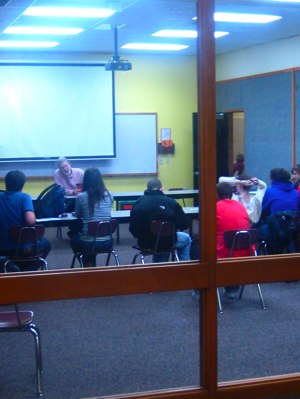 |
|
|
Admittedly, it is not the best practice for a nationally and internationally renowned expert and public speaker to confess this, but sometimes I feel out of my league. Take my most recent gig, delivering the closing keynote address for the National School Boards Association’s T+L conference, one of the true anchors of the ed tech year. I suppose it went well. Even Gary Stager, one of my frequent critics and teachers, said that although he disagreed with some of my assumptions, it was a good presentation.
But even standing before all of these education and ed technology leaders paled compared to the day before, when I worked with educators at the Seattle Academy of Arts & Sciences. I do not believe that I have ever worked with, or known a school where the spectrum between vision and business-as-usual has sided so strongly with the visionary.
There are so many details that escape me, as at least part of my attention remained on the next day’s keynote. But I remember, clearly, my conversations with Jean Orvis, the school’s director and head of school, apparently since its inception in 1983. She recently returned from a series of meetings on standards for accrediting independent schools reporting to the faculty that, “We must be paying attention to this video game thing.” Since then, students have begun to develop games using Multimedia Fusion and Alice. One of my presentations for the faculty was about video Games in education. But, that it was the students who spearheaded their attention to gaming says a lot about the school.
I spent several hours touring the school with Vicki Butler, Director of Academic Technology, and Fred Strong, Dean of Faculty. It became almost immediately clear that this school was already practicing many of the philosophies of schooling that I advocate, and they were doing it outside of the realm of “technology” — at least as we usually discuss it. For them, the community is the platform, not the motherboard. To be most accurate, they have been a 1:1 school, grades 9-12 for a number of years, requiring students to own a laptop computer. But that almost never entered into the conversation.
 |
|
|
|
 |
|
|
|
 |
|
|
The school itself, consists of several buildings scattered across several city blocks, in a gentrifying section of Seattle called Capital Hill. They include buildings, originally designed as schools, and converted retail establishments — one looking much like a former laundromat. But the unconventional appearance fades when you step inside and see learning in action. According to their web site, the school’s teacher to student ratio is 8:1, with a maximum class size of 18-20. But I saw very little class going on, and the teaching that I saw was just as frequently coming from students. You see, one of the foundational principles of the school, and one of the more intimidating factors to a staff development presenter there, is what they call performance culture.
Students write papers and take tests. But they also are required to perform what they learn. This includes formal presentations. But the arts are also a huge part of the school’s philosophical roots. Vicki (or Fred) told me about a number of their students attending a Microsoft retreat, discussing software, and that because of their comfortable, confident, and articulate interactions with the professionals, they were invited to become regular participants with the group.
Strong informed me early on that the arts and physical education were considered to be equal in all ways to the core academic subjects. All students are required to take art (drama, music, visual arts) and PE every day. I managed to finagle extra time in the arts sections of the building, where I met a drama teacher, who, with a colleague is writing a text book, an art teacher, the film teacher, and I waved to a dance instructor through a huge window.
Windows seem to be a big part of the school, as many, if not most, of the classrooms are exposed — fishbowl-style. Strong insisted that this gives the teachers a sense of performance, as other teachers and tour subjects can easily observe.
I had an especially enjoyable conversation with the film instructor, Cheryll Hidalgo. I joked about the presence of a darkroom, sixteen millimeter projector, and animation table (same type Walt Disney used), but that was mostly to shield my growing admiration for their program. Although they provide some structure for how students do their work (produce their videos) the mode of operation is learning, and students are allowed and encouraged to learn from mistakes.
I was especially interested in the fact that although the school boosts seven doctorates, 58 master , and 92 bachelor degrees, a majority of the faculty and staff are not certified teachers. This is not, in itself, impressive. What impressed me is that they keep so many of them. The number of lateral entry (North Carolina’s term for teachers who come in from other industries) who stay more than two or three years is minuscule. Teachers at this school do not merely have permission to be passionate and inventive, but it’s encouraged. A math teacher, Gary Anderson, shared with me his theory of forgetfulness. Having taught himself programming, and becoming a something something module developer for Moodle, is creating modules to measure and address student forgetfulness.
There is so much more to share about the school, but I want to close here with a realization that I had during several of my conversations. When students (and teachers) are learning and working, and they know that the are or will be, in some way, performing what they are learning to an audience of peers, and that those peers are accomplished critics, then assessment is something that you do to yourself every day.
I hope to have the chance to visit the Seattle Academy again. I hope you do too…
Powered by ScribeFire.

Thank you for sharing this inspiring story. It is my fervent wish that arts be considered a core subject at every school.
Thanks so much for this entry, David. It is great for us to see how the program looks to a very informed visitor. What you noticed and highlighted is what we think about and work hard on every day. Also, “relationships” are the bedrock foundation for us, so it was really interesting to me that relationship was such a strong theme of your presentation (and of all your thinking, it seems to me). Here are a couple other notes: About 36 hours after your presentation, our chemistry teacher had a great idea about how he was going to start using a game in conjunction with his classes. Gotta make sure that “Dance” makes it onto the list of arts disciplines you referenced. And for sure, we’d love to continue the conversation.
At the Moodle Moot I attended this summer in California, very few K-12 schools were represented – but the Seattle Academy was there. I was impressed not only with how they were using Moodle, but how Gary (as you indicated) was doing some programming on modules as well. Isn’t it great to get inspired by what is actually happening in the classroom!